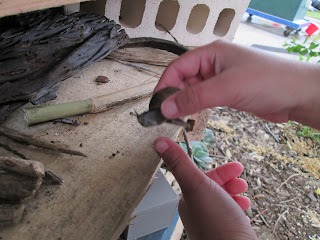 At our kindergarten, we love bugs. We love looking under rocks and stumps to find them, we love drawing them and creating artwork about them, and we love learning about them. The hard part, though, is figuring out how to express our love for bugs without hurting them. Sometimes the children's fascination includes wanting to carry them around for hours, or to put them in little boxes to take them home. As teachers, we want to encourage children's enjoyment and learning, but also introduce the understanding that we need to respect bugs and keep them safe.
At our kindergarten, we love bugs. We love looking under rocks and stumps to find them, we love drawing them and creating artwork about them, and we love learning about them. The hard part, though, is figuring out how to express our love for bugs without hurting them. Sometimes the children's fascination includes wanting to carry them around for hours, or to put them in little boxes to take them home. As teachers, we want to encourage children's enjoyment and learning, but also introduce the understanding that we need to respect bugs and keep them safe.We decided that one way to support this goal was to build a Bug Hotel. This would allow us to have a safe and special place for bugs to be taken and where we can observe them without hurting them.
We decided to be responsible and reuse materials in our construction project, so the first step was to dismantle an old pallet that had been donated. We then used old donated bricks and collected heaps of sticks, leaves, pinecones, etc. to fill it up and make cozy little niches where bugs could curl up and feel safe.

Our Bug Hotel was a success from the beginning. It only took a day to build, and then it was ready for our many-legged visitors.
The children bring over the bugs that they find, and tell them, "Welcome to the Bug Hotel!" Often the bugs will sit for a bit out on the edge of the board, where we can observe them. Then they climb back into brick or between the sticks to find a place to stay.
It didn't take long for us to realize that the wind (and some enthusiastic exploring by children) quickly depleted the store of sticks and leaves, so we all work together to keep replenishing it over time.
We also added bamboo when we came across some later, as the tiny holes are perfect for our visitors, especially in winter.
Our children started spending more time than ever finding, observing, and learning about bugs.
We have loved seeing how brave our children are - we almost never hear a child scream or run away when they see a bug. Rather, there is competition to get close enough to see and about who gets to hold it or carry it to the Bug Hotel.
After a while, we realized that our Bug Hotel was great for most bugs we found - katydids, slaters, spiders, centipedes, cockroaches, weta, snails, grasshoppers, crickets, praying mantises, etc. - but we had a problem. What about earthworms? The teachers had been encouraging the children to put them down at the bottom, but the discovery of a few dried-out ones on the top level indicated that we'd not been as hospitable to them as we'd like.
So... we built a special earthworm wing of the Bug Hotel!
Our earthworm wing is walled in by bricks, with lovely, moist soil inside. It is great for digging for worms and for burying worms that we find elsewhere. It has a lid that we made at the carpentry table to keep it nice and moist, as well as to protect the worms from the inevitable feet that will step there on the way to the rest of the Bug Hotel. Plus, it is exciting to lift up the lid to peak into the earthworm wing. Our earthworm guest are now happy and comfortable when they come to stay.
Our Bug Hotel has been a part of our teaching environment for just over a year now, and it is looking great and is still used almost every day.
We recently planted some bug-friendly plants around the Bug Hotel, but there is so much foot-traffic, they are having a bit of a hard time growing. We've added a brick path to encourage the children to walk on it instead of the plants, but that's still a work in progress. We'll continue to expand and explore our use of this area, but we are loving it so far!
If anyone has suggestions or ideas for improving our Bug Hotel, especially with regard to growing bug-friendly plants, we'd love to hear them!







Wow - I love how well you are looking after the bugs in your kindergarten! It looks like you have a great hotel for them to live in. Here is a link to some other ideas for bug hotels. http://www.inspirationgreen.com/insect-habitats.html. Keep up the fantastic learning!
ReplyDelete